Mount Athos
| |
|---|---|
 Location and extent of Mount Athos (red) in Greece. | |
| Capital | Karyesa |
| Language | Greek |
| Religion | Eastern Orthodoxy |
| Demonym(s) |
|
| Country | |
| Government | autonomous theocratic society led by ecclesiastical council |
• Civil Governor | Aristos Kasmiroglou |
• Protos (Elder Monk) | Elder Stefanos Chilandrinos |
| Autonomy | |
• Constitutional reaffirmation |
|
| Area | |
• Total | 335.63 km2 (129.59 sq mi) |
| Population | |
• 2011 census | 1,811 |
• Density | 5.40/km2 (14.0/sq mi) |
Sovereign monasteries
| |
| Mount Athos | |
|---|---|
 | |
| Highest point | |
| Elevation | 2,030 m (6,660 ft) |
| Prominence | 2,012 m (6,601 ft) |
| Listing | Ultra |
| Geography | |
 | |
| Location | Greece |
| Type | Mixed |
| Criteria | i, ii, iv, v, vi, vii |
| Designated | 1988 (12th session) |
| Reference no. | 454 |
| State Party | Greece |
| Region | Europe and North America |
Mount Athos (/ˈæθɒs/; Greek: Όρος Άθως, [Οros Αthos] Error: {{Lang}}: text has italic markup (help) [ˈoros ˈaθos]) is a mountain and peninsula in Northern Greece. A World Heritage Site and autonomous polity within the Hellenic Republic under the official name Autonomous Monastic State of the Holy Mountain ([Αὐτόνομη Μοναστικὴ Πολιτεία Ἁγίου Ὄρους, Aftonomi Monastiki Politia Agiou Orous] Error: {{Lang-xx}}: text has italic markup (help)), Mount Athos is home to 20 stauropegial Eastern Orthodox monasteries under the direct jurisdiction of the Ecumenical Patriarch of Constantinople.
Mount Athos is commonly referred to as the "Holy Mountain" ([Ἅγιον Ὄρος, Agion Oros] Error: {{Lang-xx}}: text has italic markup (help) [ˈaʝ(i)o(n) ˈoros]) and the entity as the "Athonite State" ([Αθωνική Πολιτεία, Athoniki Politia] Error: {{Lang-xx}}: text has italic markup (help)). In the Classical era, while the mountain was called Athos, the peninsula was known as Acté or Akté (Ἀκτὴ).
Mount Athos has been inhabited since the ancient times and is known for its nearly 1,800-year continuous Christian presence and its long historical monastic traditions, which date back to at least 800 A.D. and the Byzantine era. Today, over 2,000 monks from Greece and many other Eastern Orthodox countries, such as Romania, Moldova, Bulgaria, Serbia and Russia, live an ascetic life in Athos, isolated from the rest of the world. The Athonite monasteries feature a rich collection of well-preserved artifacts, rare books, ancient documents, and artworks of immense historical value.
Although Mount Athos is technically part of the European Union like the rest of Greece, the status of the Monastic State of the Holy Mountain, and the jurisdiction of the Athonite institutions, were expressly described and ratified upon admission of Greece to the European Community (precursor to the EU). The free movement of people and goods in its territory is prohibited, unless formal permission is granted by the Monastic State's authorities.
Geography


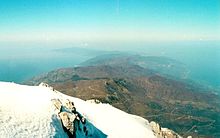
The peninsula, the easternmost "leg" of the larger Chalkidiki peninsula in central Macedonia, protrudes 50 kilometres (31 mi)[3] into the Aegean Sea at a width of between 7 and 12 kilometres (4.3 and 7.5 mi) and covers an area of 335.6 square kilometres (129.58 sq mi). The actual Mount Athos has steep, densely forested slopes reaching up to 2,033 metres (6,670 ft). The surrounding seas, especially at the end of the peninsula, can be dangerous. In ancient Greek history two fleet disasters in the area are recorded: In 492 BC Darius, the king of Persia, lost 300 ships under general Mardonius (Herodotus "Histories" book VI (Erato), Aeschylus "The Persians"). In 411 BC the Spartans lost a fleet of 50 ships under admiral Epicleas. (Diodorus Siculus, "Bibliotheca historica" XIII 41, 1–3).
Though land-linked, Mount Athos is practically accessible only by ferry. The Agios Panteleimon and Axion Estin travel daily (weather permitting) between Ouranoupolis and Dafni, with stops at some monasteries on the western coast. There is also a smaller speed boat, the Agia Anna, which travels the same route, but with no intermediate stops. It is possible to travel by ferry to and from Ierissos for direct access to monasteries along the eastern coast.
Access
The number of daily visitors to Mount Athos is restricted, and all are required to obtain a special entrance permit valid for a limited period. Only males are permitted to visit the territory, which is called "Garden of Virgin Mary" by the monks,[4] with Orthodox Christians taking precedence in permit issuance procedures. Residents on the peninsula must be males aged 18 and over who are members of the Eastern Orthodox Church, and must be either monks or workers.
History
Antiquity
Athos in Greek mythology is the name of one of the Gigantes that challenged the Greek gods during the Gigantomachia. Athos threw a massive rock against Poseidon which fell in the Aegean sea and became Mount Athos. According to another version of the story, Poseidon used the mountain to bury the defeated giant.
Homer mentions the mountain Athos in the Iliad (book 14, 229). Herodotus (VI.44) writes that, during the Persian invasion of Thrace in 492 BC, the fleet of the Persian commander Mardonius was wrecked, with losses of 300 ships and 20,000 men, by a strong North wind while attempting to round the coast near Mount Athos. Herodotus mentions the peninsula, then called Acte or Akte, telling us that Pelasgians from the island of Lemnos populated it and naming five cities thereon, Sane, Cleonae (Kleonai), Thyssos (Thyssus), Olophyxos (Olophyxis), Acrothoï (Akrothoön). (Herodotus, VII:22) Strabo also mentions the city of Dion (Dium) and that Acrothoï is near the crest. (Strabo, Geography, VII:33:1)[5] Eretria also established colonies on Acte. At least one other city was established in the Classical period: Acanthus (Akanthos). Some of these cities minted their own coins.
The peninsula was on the invasion route of Xerxes I, who spent three years[6] excavating a channel across the isthmus to allow the passage of his invasion fleet in 483 BC. After the death of Alexander the Great, the architect Dinocrates (Deinokrates) proposed to carve the entire mountain into a statue of Alexander.
The history of the peninsula during latter ages is shrouded by the lack of historical accounts. Archaeologists have not been able to determine the exact location of the cities reported by Strabo. It is believed that they must have been deserted when Athos' new inhabitants, the monks, started arriving some time before the ninth century AD.[7]
Early Christianity
According to the Athonite tradition, the Blessed Virgin Mary was sailing accompanied by St John the Evangelist from Joppa to Cyprus to visit Lazarus. When the ship was blown off course to then pagan Athos it was forced to anchor near the port of Klement, close to the present monastery of Iviron. The Virgin walked ashore and, overwhelmed by the wonderful and wild natural beauty of the mountain, she blessed it and asked her Son for it to be her garden. A voice was heard saying "Ἔστω ὁ τόπος οὖτος κλῆρος σὸς καὶ περιβόλαιον σὸν καὶ παράδεισος, ἔτι δὲ καὶ λιμὴν σωτήριος τῶν θελόντων σωθῆναι" (Translation: "Let this place be your inheritance and your garden, a paradise and a haven of salvation for those seeking to be saved"). From that moment the mountain was consecrated as the garden of the Mother of God and was out of bounds to all other women.[note 1]
Historical documents on ancient Mount Athos history are very few. It is certain that monks have been there since the fourth century, and possibly since the third. During Constantine I's reign (324–337) both Christians and pagans were living there. During the reign of Julian the Apostate (361–363), the churches of Mount Athos were destroyed, and Christians hid in the woods and inaccessible places.[citation needed] Later, during Theodosius I's reign (383–395), the pagan temples were destroyed. The lexicographer Hesychius of Alexandria states that in the fifth century there was still a temple and a statue of "Zeus Athonite". After the Islamic conquest of Egypt in the seventh century, many orthodox monks from the Egyptian desert tried to find another calm place; some of them came to the Athos peninsula. An ancient document states that monks "built huts of wood with roofs of straw [...] and by collecting fruit from the wild trees were providing themselves improvised meals."[note 2]
Byzantine era: the first monasteries



The chroniclers Theophanes the Confessor (end of eighth century) and Georgios Kedrenos (11th century) wrote that the 726 eruption of the Thera volcano was visible from Mount Athos, proving that it was inhabited at the time. The historian Genesios recorded that monks from Athos participated at the seventh Ecumenical Council of Nicaea of 787. Following the Battle of Thasos in 829, Athos was deserted for some time due to the destructive raids of the Cretan Saracens. Around 860, the famous monk Efthymios the Younger came to Athos and a number of monk-huts ("skete of Saint Basil") were created around his habitation, possibly near Krya Nera. During the reign of emperor Basil I the Macedonian, the former Archbishop of Crete (and later of Thessaloniki) Basil the Confessor built a small monastery at the place of the modern harbour ("arsanas") of Hilandariou Monastery. Soon after this, a document of 883 states that a certain Ioannis Kolovos built a monastery at Megali Vigla.
On a chrysobull of emperor Basil I, dated 885, the Holy Mountain is proclaimed a place of monks, and no laymen or farmers or cattle-breeders are allowed to be settled there. The next year, in an imperial edict of emperor Leo VI the Wise we read about the "so-called ancient seat of the council of gerondes (council of elders)", meaning that there was already a kind of monks' administration and that it was already "ancient". In 887, some monks expostulate to the emperor Leo the Wise as the monastery of Kolovos is growing more and more and they lose their peace.
In 908, the existence of a Protos ("First monk"), the "head" of the monastic community, is documented. In 943, the borders of the monastic state were precisely mapped while we know that Karyes is already the capital town and seat of the administration and has the name "Megali Mesi Lavra" (Big Central Assembly). In 956, a decree offered land of about 940,000 m2 (10,118,075.79 sq ft) to the Xiropotamou monastery, which means that this monastery was already quite big.
In 958, the monk Athanasios the Athonite (Άγιος Αθανάσιος ο Αθωνίτης) arrived on Mount Athos. In 962, he built the big central church of the "Protaton" in Karies. In the next year, with the support of his friend, Emperor Nicephorus Phocas, the monastery of Great Lavra was founded, still the largest and most prominent of the twenty monasteries existing today. It enjoyed the protection of the emperors of the Byzantine Empire during the following centuries, and its wealth and possessions grew considerably. The Fourth Crusade in the 13th century brought new Roman Catholic overlords which forced the monks to complain and ask for the intervention of Pope Innocent III, until the restoration of the Byzantine Empire came. The peninsula was raided by Catalan mercenaries in the 14th century, a century that also saw the theological conflict over the hesychasm practised on Mount Athos and defended by Gregory Palamas (Άγιος Γρηγόριος ο Παλαμάς).
Ottoman era
The Byzantine Empire was conquered in the 15th century and the Ottoman Empire took its place. The Athonite monks tried to maintain good relations with the Ottoman Sultans and therefore when Murad II conquered Thessaloniki in 1430 they immediately pledged allegiance to him. In return, Murad recognized the monasteries' properties, something which Mehmed II formally ratified after the fall of Constantinople in 1453. In this way the Athonite independence was somewhat guaranteed.
From the account of Russian pilgrim Isaiah by the end of the 15th century half of the monasteries were either Slav or Albanian, in particular, Docheiariou, Grigoriou, Ayiou Pavlou, Ayiou Dionysiou, and Chilandariou were Serbian, Karakalou and Philotheou were Albanian, Panteleïmon was Russian, Simonopetra was Bulgarian, Pantokratoros and Stavronikita was Greek while he mentions that Zographou, Kastamonitou, Xeropotamou, Koutloumousiou, Xenophontos, Iviron and Protaton did not bear any designation.[8]
The 15th and 16th centuries were particularly peaceful for the Athonite community. This led to relative prosperity for the monasteries. An example of this is the foundation of Stavronikita monastery which completed the current number of Athonite monasteries. Following the conquest of the Serbian Despotate by the Ottomans many Serbian monks came to Athos. The extensive presence of Serbian monks is depicted in the numerous elections of Serbian monks to the office of the Protos during the era.
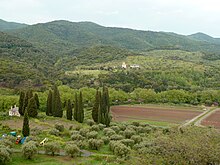
Sultan Selim I was a substantial benefactor of the Xiropotamou monastery. In 1517, he issued a fatwa and a Hatt-i Sharif ("noble edict") that "the place, where the Holy Gospel is preached, whenever it is burned or even damaged, shall be erected again." He also endowed privileges to the Abbey and financed the construction of the dining area and underground of the Abbey as well as the renovation of the wall paintings in the central church that were completed between the years 1533–1541.[9]
Although most time the monasteries were left on their own, the Ottomans heavily taxed them and sometimes they seized important land parcels from them.[citation needed] This eventually culminated in an economic crisis in Athos during the 17th century. This led to the adoption of the so-called "idiorrhythmic" lifestyle (a semi-eremitic variant of Christian monasticism) by a few monasteries at first and later, during the first half of the 18th century, by all.
This new way of monastic organization was an emergency measure taken by the monastic communities to counter their harsh economic environment. Contrary to the cenobitic system, monks in idiorrhythmic communities have private property, work for themselves, they are solely responsible for acquiring food and other necessities and they dine separately in their cells, only meeting with other monks at church. At the same time, the monasteries' abbots were replaced by committees and at Karyes the Protos was replaced by a four-member committee.[10]
In 1749, with the establishment of the Athonite Academy near Vatopedi monastery, the local monastic community took a leading role in the modern Greek Enlightenment movement of the 18th century.[11] This institution offered high level education, especially under Eugenios Voulgaris, where ancient philosophy and modern physical science were taught.[12]
Russian tsars, and princes from Moldavia, Wallachia and Serbia (until the end of the 15th century), helped the monasteries survive with large donations. The population of monks and their wealth declined over the next centuries, but were revitalized during the 19th century, particularly by the patronage of the Russian government. As a result, the monastic population grew steadily throughout the century, reaching a high point of over 7,000 monks in 1902.[note 3]
In November 1912, during the First Balkan War, the Ottomans were forced out by the Greek Navy.[13] Greece claimed the peninsula as part of the peace treaty of London signed on 30 May 1913. As a result of the shortcomings of the Treaty of London, the Second Balkan War broke out between the combatants in June 1913. A final peace was agreed at the Treaty of Bucharest on 10 August 1913.
In June 1913, a small Russian fleet, consisting of the gunboat Donets and the transport ships Tsar and Kherson, delivered the archbishop of Vologda, and a number of troops to Mount Athos to intervene in the theological controversy over imiaslavie (a Russian Orthodox movement).
The archbishop held talks with the imiaslavtsy and tried to make them change their beliefs voluntarily, but was unsuccessful. On 31 July 1913, the troops stormed the St. Panteleimon Monastery. Although the monks were not armed and did not actively resist, the troops showed very heavy-handed tactics. After the storming of St. Panteleimon Monastery, the monks from the Andreevsky Skete (Skiti Agiou Andrea) surrendered voluntarily. The military transport Kherson was converted into a prison ship and more than a thousand imiaslavtsy monks were sent to Odessa where they were excommunicated and dispersed throughout Russia.
After a brief diplomatic conflict between Greece and Russia over sovereignty, the peninsula formally came under Greek sovereignty after World War I.
Modern times

The self-governed region of the Holy Mountain, according to the Decree passed by the Holy Community on 3 October 1913 and according to the international treaties of London (1913), Bucharest (1913), Neuilly (1919), Sèvres (1920) and Lausanne (1923), is considered part of the Greek state. The Decree, "made in the presence of the Holy Icon of Axion Estin", stated that the Holy Community recognised the Kings of Greece as the lawful sovereigns and "successors on the Mountain" of the "Emperors who built" the monasteries and declared its territory as belonging to the then Kingdom of Greece.
Political instability in Greece during the mid-20th century that affected Mount Athos included Nazi occupation from the Easter season of 1941 through late 1944, followed immediately by the Greek Civil War in a struggle where Communist efforts failed. The Battle of Greece was reported in Time Magazine, "The Stukas swooped across the Aegean skies like dark, dreadful birds, but they dropped no bombs on the monks of Mount Athos".[14] After the Nazi takeover of Greece, the Epistassia, Athos's four-member executive committee, formally asked Hitler to place the Autonomous Monastic State under his personal protection, and Hitler agreed. Mount Athos survived World War II nearly untouched, and for the remainder of the war, the monks of Mount Athos referred to Adolf Hitler as "High Protector of the Holy Mountain" (German: Hoher Protektor des heiligen Berges).[15]
Later a "Special Double Assembly" of the Holy Community in Karyes passed the "Constitutional Charter" of the Holy Mountain, which was ratified by the Greek Parliament. This regime originates from the "self-ruled monastic state" as stated on a chrysobull parchment signed and sealed by the Byzantine Emperor Ioannis Tzimisces in 972.[citation needed] This important document is preserved in the House of the Holy Administration in Karyes. The self-rule of the Holy Mountain was later reaffirmed by the Emperor Alexios I Komnenos in 1095.
According to the constitution of Greece,[16] Mount Athos (the "Monastic State of Agion Oros") is, "following ancient privilege", "a self-governed part of the Greek State, whose sovereignty thereon shall remain intact", and consists of 20 main monasteries which constitute the Holy Community, and the capital town and administrative centre, Karyes, also home to a governor as the representative of the Greek state. The governor is an executive appointee. The status of the Holy Mountain and the jurisdiction of the Agiorite institutions were expressly described and ratified upon admission of Greece to the European Union (then the European Community).
On 11 September 2004, the Eastern Orthodox Patriarch of Alexandria, Peter VII, was killed, together with 16 others, when a Greek military Chinook helicopter in which he was travelling crashed in the Aegean Sea off the peninsula. The Patriarch was heading to Mount Athos. The cause of the crash remains unknown.[17][18]
The monasteries of Mount Athos have a history of opposing ecumenism, or movements towards reconciliation between the Orthodox Church of Constantinople and the Roman Catholic Church. The Esphigmenou monastery is particularly outspoken in this respect, having raised black flags to protest against the meeting of Patriarch Athenagoras I of Constantinople and Pope Paul VI in 1972. Esphigmenou was subsequently expelled from the representative bodies of the Athonite Community. The conflict escalated in 2002 with Patriarch Bartholomew I of Constantinople declaring the monks of Esphigmenou an illegal brotherhood and ordering their eviction; the monks refused to be evicted, and the Patriarch ordered a new brotherhood to replace them.
After reaching a low point of just 1,145 mainly elderly monks in 1971, the monasteries have been undergoing a steady and sustained renewal. By the year 2000, the monastic population had reached 1,610, with all 20 monasteries and their associated sketes receiving an infusion of mainly young well-educated monks. In 2009, the population stood at nearly 2,000.[3] Many younger monks possess university education and advanced skills that allow them to work on the cataloging and restoration of the Mountain's vast repository of manuscripts, vestments, icons, liturgical objects and other works of art, most of which remain unknown to the public because of their sheer volume. Projected to take several decades to complete, this restorative and archival work is well under way, funded by UNESCO and the EU, and aided by many academic institutions.
Administration and organization

Athos is governed by the "Holy Community" (Ιερά Κοινότητα – Iera Koinotita) which consists of the representatives of the 20 Holy Monasteries, having as executive committee the four-membered "Holy Administration" (Ιερά Επιστασία – Iera Epistasia), with the Protos (Πρώτος) being its head.
Civil authorities are represented by the Civil Governor, appointed by the Greek Ministry of Foreign Affairs, whose main duty is to supervise the function of the institutions and the public order. The current Civil Governor is Aristos Kasmiroglou.[22]
In each of the 20 monasteries – which today all follow again the coenobitic system – the administration is in the hands of the Abbot (Ηγούμενος – Hēgoumenos) who is elected by the brotherhood for life. He is the lord and spiritual father of the monastery. The Convention of the brotherhood (Γεροντία) is the legislative body. All the other establishments (sketes, cells, huts, retreats, hermitages) are dependencies of some of the 20 monasteries and are assigned to the monks by a document called "homologon" (ομόλογον).
All persons leading a monastic life thereon acquire Greek citizenship without further formalities, upon admission as novices or monks. Visits to the peninsula are possible for laymen, but they need a special permit known as a diamonētērion (διαμονητήριον), similar to a visa.
Of the 20 monasteries located on the Holy Mountain, the brethren of 17 are predominantly ethnically Greek. Of the other 3, brethren are drawn from monks of primarily other origins, who become Greek subjects. These are the Helandariou Monastery (Serbian), the Zografou Monastery (Bulgarian) and the Agiou Panteleimonos Monastery (Russian).
Among the sketes, most are predominantly ethnic Greek. However, two are Romanian, the coenobitic "Skētē Timiou Prodromou" (which belongs to the Megistis Lavras Monastery) and the idiorrythmic "Skētē Agiou Dēmētriou tou Lakkou", also called "Lakkoskētē" (which belongs to the Agiou Pavlou Monastery). Another one is Bulgarian, "Skētē Bogoroditsa" (which belongs to the Agiou Panteleimonos Monastery).
Visiting procedure

Entry to the mountain is usually by ferry boat either from the port of Ouranoupoli (for west coast monasteries) or from Ierrisos for those on the east coast. Before embarking on the boat all visitors must have been issued a diamonētērion (διαμονητήριον), a form of Byzantine visa that is written in Greek, dated using the Julian calendar, and signed by four of the secretaries of leading monasteries. Clergy of the Orthodox Church are required to obtain permission of the Patriarch of Constantinople. For laymen there are generally two kinds of diamonētēria: the general diamonētērion that enables the visitor to stay overnight at any one of the monasteries but only to stay in the mountain for several days (more in winter, when there are fewer visitors, than in summer), and the special diamonētērion which allows a visitor to visit only one monastery or skete but to stay as many days as he has agreed with the monks. Laymen are required to have short hair and any non-cleric arriving on Athos with long hair has his hair cut. The general diamonētērion is available upon application to the Pilgrims' Bureau in Thessaloniki. Once this has been granted it will be issued at the port of departure, on the day of departure. Once granted, the pilgrim can contact the monastery where he would like to stay in order to reserve a bed (one night only per monastery). The ferries require reservations, both ways.
The duration of the general visa can be extended by several days by personally applying at the main office in Karyes or, as is done typically for someone seeking to become a monk, by a request from a monastery.
Most visitors arrive at the small port of Dafni from where they can take the only paved road in the mountain to the capital Karyes or continue via another smaller boat to other monasteries down the coast. There is a public bus between Dafni and Karyes. Expensive taxis operated by monks are available for hire at Dafni and Karyes. They are all-wheel drive vehicles since most roads in the mountain are unpaved. Visitors to monasteries on the mountain's western side prefer to stay on the ferry and disembark at the monastery they wish to visit.
Prohibition on entry for women

There is a prohibition on entry for women, called avaton (Άβατον) in Greek, to make living in celibacy easier for those who have chosen to do so.[23] Monks feel that the presence of women alters the social dynamics of the community and therefore slows their path towards spiritual enlightenment. The ban was officially proclaimed by the Byzantine emperor Constantine Monomachos, as a chrysobull, in 1046.[24]
In the 14th century, Serbian Emperor Dušan the Mighty brought his wife, Helena of Bulgaria, to Mount Athos to protect her from the plague, but she did not touch the ground during her entire visit, as she was carried in the hand carriage all the time.[25]
French writer Maryse Choisy entered Mount Athos in the 1920s disguised as a sailor, and later wrote about her escapade in Un mois chez les hommes ("A Month With Men").[26]
There was an incident in the 1930s regarding Aliki Diplarakou, the first Greek beauty pageant contestant to win the Miss Europe title, who shocked the world when she dressed up as a man and sneaked into Mount Athos. Her escapade was discussed in the 13 July 1953, Time magazine article entitled "The Climax of Sin".[27]
In 1953, Cora Miller, an American Fulbright Program teacher from Athens, Ohio, landed briefly along with two other women, stirring up a controversy among the local monks.[28]
A 2003 resolution of the European Parliament requested lifting the ban for violating "the universally recognised principle of gender equality".[29]
On 26 May 2008, five Moldovans illegally entered Greece by way of Turkey, ending up on Athos; four of the migrants were women. The monks forgave them for trespassing and informed them that the area was forbidden to females.[30]
Status in the European Union
As part of an EU member state, Mount Athos is part of the European Union and, for the most part, subject to EU law. While outside the EU's Value Added Tax area, Mount Athos is part of the Schengen Area.[31] A declaration attached to Greece's accession treaty to the Schengen Agreement states that Mount Athos' "special status" should be taken into account in the application of the Schengen rules.[32] The monks strongly objected to Greece joining the Schengen Area based on fears that the EU would be able to end the centuries-old prohibition on the admittance of women.[33] However the prohibition persists and a special permit is required to enter the peninsula. The monks are also worried that the agreement could affect their traditional right to offer sanctuary to people from orthodox countries such as Russia and Serbia.[33] Such monks do nowadays need a Greek visa and permission to stay, even if that is given generously by the Greek ministry, based on requests from Athos.[34]
Culture and life in the Agion Oros
Art and literary treasures
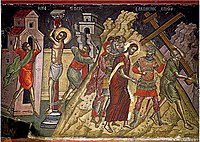



The Athonite monasteries possess huge deposits of invaluable medieval art treasures, including icons, liturgical vestments and objects (crosses, chalices), codices and other Christian texts, imperial chrysobulls, holy relics etc. Until recently no organized study and archiving had been carried out, but an EU-funded effort to catalogue, protect and restore them is underway since the late 1980s. Their sheer number is such, it is estimated that several decades will pass before the work is completed.
Among the most ancient and priceless codices at Mount Athos are the Codex Athous Lavrensis and the Codex Athous Dionysiou.
Languages
Greek is commonly used in all the Greek monasteries, but in some monasteries there are other languages in use: in Agiou Panteleimonos, Russian (50 monks in 2006); in Helandariou Monastery, Serbian (46); in Zographou Monastery and Skiti Bogoroditsa, Bulgarian (32); and in the sketes of Timiou Prodromou and Lakkoskiti, Romanian (64). Today, many of the Greek monks also speak foreign languages. Since there are monks from many nations in Athos, they naturally also speak their own native languages.
Date and time reckoning
The Julian calendar, nowadays having a difference of 13 days from the Gregorian calendar, is still used on Mount Athos. In 1923, as a means to eliminate the divergence existing between the religious and civil dates, after a synod in Constantinople, part of the Eastern Orthodox Churches dropped 13 days and adopted the Revised Julian calendar, which is synchronised with the Gregorian calendar, at least until 2800.[note 4] However, although under the direct jurisdiction of the Ecumenical Patriarchate of Constantinople, the spiritual head of the monastic state, nearly all the monasteries of Athos refused to follow the revised calendar and finally, for the sake of uniformity, the patriarch asked the single monastery that used the revised calendar to revert to the Julian.
Also in use is Byzantine time, in which the day commences at sunset as does the liturgical day[note 5] and not at midnight as in the reckoning of civil time, and the difference between the two varies according to the season of the year. Because the time interval from sundown to sundown is not constant, clocks showing the Byzantine time require continual manual readjusting which in current practice is done weekly, on Saturday, if the sky is clear; where the summit of Athos is visible, 12:00 is set when the last rays of sunlight cease to shine on the tip. Some monasteries also have a clock showing civil time since boat schedules run thereon (and on the civil calendar) as well as for pilgrims who may be disoriented by Byzantine time reckoning.
Monastic life: monasteries, sketae, and cells
As described above, today the 20 monasteries of Mount Athos are the dominant holy institutions for both spiritual and administrative purposes, consolidated by the Constitutional Chart of the Holy Mountain. Although, since the beginning of Mount Athos' history, monks were living in lodgings of different size and construction quality. All these monastic lodging types exist until today, named as seats (καθίσματα), cells (κελλιά), huts (καλύβες), retreats (ησυχαστήρια), hermitages (ερημιτήρια), caves (σπήλαια), sketae (σκήτες) and all of them are known under the general term "dependencies" (εξαρτήματα) of the Holy Monasteries. The term "cells" can be used under a more generalised meaning, comprising all the above but sketae, and following this term we can talk about three different kind of institutions in Mount Athos: monasteries, sketae and cells.
Monasteries
Some information is already given above, in the section "Administration and organization". A pilgrim/visitor to a monastery, who is accommodated in the guest-house (αρχονταρίκι) can have a taste of the monastic life in it by following its daily schedule: praying (services in church or in private), common dining, working (according to the duties of each monk) and rest. During religious celebrations usually long vigils are held and the entire daily program is radically reshaped. The gate of the monastery closes by sunset and opens again by sunrise.
Cells
A cell is a house with a small church, where 1–3 monks live under the spiritual and administrative supervision of a monastery. Monastic life in the cells is totally different from that in a monastery. Some of the cells resemble tidy farmhouses, others are poor huts, others have the gentility of Byzantine tradition or of Russian architecture of the past century. Usually, each cell possesses a piece of land for agricultural or other use. Each cell has to organize some activities for income. Besides the traditional occupations (agriculture, fishing, woodcarving, spirit distillation, iconography, tailoring, book binding etc.) new occupations have been taken up, for example taxi driving, couriers, car repairing and computer services. The monk(s) living in a cell, having to take care of all daily chores, make up their own schedules. For the pilgrim/visitor it is worth experiencing this side of monastic life as well, but most of the cells have very limited or no capacity for hospitality.
Sketes

Small communities of neighbouring cells were developed since the beginning of monastic life on Mount Athos and some of them were using the word "skete" (σκήτη) meaning "monastic settlement" or "lavra" (λαύρα) meaning "monastic congregation". The word "skete" is of Coptic origin and in its original form is a placename of a location in the Egyptian desert.[35] It is in the Egyptian desert where monasticism made its first steps. The unknown author of the "History of the Egyptian Monks" (Historia Monachorum in Aegypto), perhaps Flavius Rufinus visited the area at the end of the fourth century. He tells us: "Then we came to Nitria, the best-known of all monasteries of Egypt, about forty miles [60 km] from Alexandria; it takes its name from a nearby town where Nitre is collected... In this place there are about fifty dwellings, or not many less, set near together and under one father. In some of them, there are many living together, in others a few and in some there are brothers who live alone. Though they are divided by their dwellings they remain bound together and inseparable in faith and love". This is exactly the main idea of a "skete", the communal way, just between the hermetic way and the coenobitic way of monasticism, with all 3 coexisting until today.
In 1680 the ex-patriarch Dionysios III Vardalis built in Saint Anne skete of the Holy Mountain a big central church to accommodate all the monks of the area and in 1689 an internal regulatory text was constituted by the monks and ratified first by the Monastery of Megisti Lavra and finally by the patriarch Dionysios V Haritonidis; and later again by patriarch Kyrilos V, who contributed in its evolution. Since then, more sketes followed on the same way, and gradually the term "skete" (within the Holy Mountain) came to be used only for the monastic settlements having an internal rule ratified by the Patriarchate.
Later on, some cells came to attract many monks, expanded their buildings and started functioning in the coenobitic way of the monasteries. Since the number of the Monasteries in Mount Athos was restricted to 20, a new term was introduced: the "coenobitic skete" (κοινόβιος σκήτη), while a skete of the traditional form was named "idiorrythmic skete" (ιδιόρρυθμος σκήτη) in order to underline the difference.
The first ones, both in architecture and life-style, follow the typical model of a monastery, that of a community living together, sharing and distributing work, and praying together daily. In contrast, the idiorrhythmic community (intermediary between the ceonobitic community and the seclusion of a hermit) resembles a hamlet, and the daily life there is much like that of a cell. But there are also some duties for the community. Near the centre of the settlement is the central church called Kyriakon (Κυριακόν, that could be translated "for Sunday"), where the whole brotherhood meets for the Divine Liturgy service, on Sundays and on greater feasts. Usually there are also an administration house, a refectory for common celebrations, a cemetery, a library, storehouses and a guesthouse.
List of religious institutions
Twenty monasteries
The sovereign monasteries, in the order of their place in the Athonite hierarchy:
| Great Lavra monastery | Vatopedi monastery | Iviron monastery | Helandariou monastery | Dionysiou monastery |
|---|---|---|---|---|
| Μεγίστη Λαύρα | Βατοπέδι | Ιβήρων ივერთა მონასტერი |
Χιλανδαρίου Хиландар |
Διονυσίου |
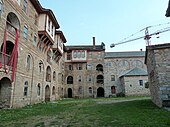
|

|

|
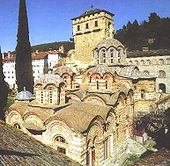
|
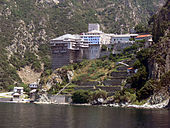
|
| Koutloumousiou monastery | Pantokratoros monastery | Xiropotamou monastery | Zografou monastery | Docheiariou monastery |
| Κουτλουμούσι | Παντοκράτορος | Ξηροποτάμου | Ζωγράφου Зограф |
Δοχειαρίου |

|
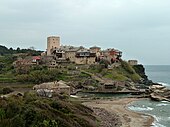
|

|
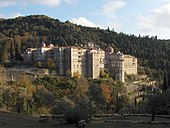
|
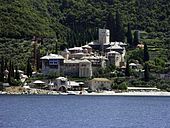
|
| Karakalou monastery | Filotheou monastery | Simonos Petras monastery | Agiou Pavlou monastery | Stavronikita monastery |
| Καρακάλλου | Φιλοθέου | Σίμωνος Πέτρα | Αγίου Παύλου | Σταυρονικήτα |

|
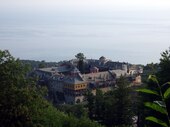
|
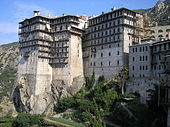
|

|
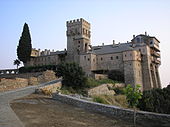
|
| Xenophontos monastery | Osiou Grigoriou monastery | Esphigmenou monastery | Agiou Panteleimonos monastery | Konstamonitou monastery |
| Ξενοφώντος | Οσίου Γρηγορίου | Εσφιγμένου | Αγίου Παντελεήμονος Пантелеймонов |
Κωνσταμονίτου |

|

|

|
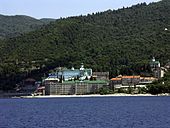
|
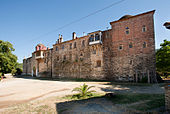
|
Twelve sketes
A skete is a community of Christian hermits following a monastic rule, allowing them to worship in comparative solitude, while also affording them a level of mutual practical support and security. There are two kinds of sketes in Mount Athos. A koenobitic skete follows the style of monasteries. An idiorrhythmic skete follows the style of a small village: it has a common area of worship (a church), with individual hermitages or small houses around it, each one for a small number of occupants. There are 12 official sketes on Mount Athos.
| Skiti / Σκήτη | Type | Monastery | Alternative names / notes |
|---|---|---|---|
| Agias Annas
Αγίας Άννας |
idiorrhythmic | Megistis Lavras | (=Saint Anne)
Agiánna |
| Agias Triados or Kafsokalyvíon
Αγίας Τριάδος ή Καυσοκαλυβίων |
idiorrhythmic | Megistis Lavras | (=Holy Trinity)
Kafsokalývia (="burned huts") |
| Timiou Prodromou
Τιμίου Προδρόμου |
coenobitic | Megistis Lavras | (=Holy Fore-runner, i.e. St John the Baptist)
Prodromu, Sfântul Ioan Botezătorul – Romanian |
| Agiou Andrea
Αγίου Ανδρέα |
coenobitic | Vatopediou | (=Saint Andrew)
also known as Saray (Σαράι) |
| Agiou Dimitriou
Αγίου Δημητρίου |
idiorrhythmic | Vatopediou | (=Saint Demetre)
Vatopediní |
| Timiou Prodromou Iviron
Τιμίου Προδρόμου Ιβήρων |
idiorrhythmic | Iviron | (=Holy Forerunner, i.e. St John the Baptist)
Ivirítiki |
| Agiou Panteleimonos
Αγίου Παντελεήμονος |
idiorrhythmic | Koutloumousiou | (=Saint Panteleimon/Pantaleon)
Koutloumousianí |
| Profiti Ilia
Προφήτη Ηλία |
coenobitic | Pantokratoros | (=Prophet Elijah) |
| Theotokou or Nea Skiti
Θεοτόκου ή Νέα Σκήτη |
idiorrhythmic | Agiou Pavlou | (=of God-Bearer or New Skete) |
| Agiou Dimitriou tou Lakkou or Lakkoskiti
Αγίου Δημητρίου του Λάκκου ή Λακκοσκήτη |
idiorrhythmic | Agiou Pavlou | (=Saint Demetre of the Ravine or Ravine-Skete)
Lacu, Sfântul Dumitru – Romanian |
| Evangelismou tis Theotokou
Ευαγγελισμού της Θεοτόκου |
idiorrhythmic | Xenophontos | (=Annunciation of Theotokos)
Xenofontiní |
| Bogoroditsa
Βογορόδιτσα |
coenobitic | Agiou Panteleimonos | (=Theotokos, God-Bearer)
Богородица – Bulgarian |
Main settlements
Philately and postal history
Russian post office and stamps
A Russian post office was established at Karyai in the last years of the 19th Century. This post office was selling Russian Levant stamps and, from 1910, special ROPIT (Р.Ο.П.и.Т.) stamps overprinted with "Mont-Athos" and values in Ottoman currency.[36]
Contemplated WW1 allied postage stamp issue
In the winter of 1915–1916 the Allied forces were considering occupation of the Holy Mountain. In anticipation of this they prepared a set of stamps which were intended for issue on 25 January 1916 for the use of the Governing body of the Monastic Community.
These stamps were produced in sheets of 12, (3 rows of 4), on board the seaplane carrier HMS Ark Royal. Six values were produced, ranging up to one shilling, and all were printed in black but on various different paper types.
The design of these stamps consisted of a square border with the name MOUNT ATHOS at the bottom in English, the left in Russian and on the right in Greek. At the top was inscribed THEOCRACY. The denomination appeared at each corner with the English in the lower corners, Greek in the top left and Russian in the top right. The inner section showed a double headed Byzantine eagle with the effigy of the Madonna and Child in an oval on its breast.
These stamps have no official status but fall into the category of prepared for use but not issued.
Greek 1916 overprint
For political reasons in 1916 the Greek Government overprinted Greek "Campaign 1912" and postage due (1913 issue) stamps, as well as postal stationery, with the inscription "Ι. Κοινότης Αγ. Όρους" (Holy Community of Sacred Mountain). The decision was recalled before the stamps were officially issued.[37]
Stamp issues 2008 to date
In 2008 the Hellenic Postal Service started issuing Mount Athos postage stamps for postal use only at the post offices in Karyai and Dafni. The first set of five stamps was issued on 16 May 2008. A second set of five stamps was issued on 13 June 2008. Mount Athos continues to issue stamps today.
Friends organisation
The Friends of Mount Athos is a society formed in 1990 by people who shared a common interest for the monasteries of Mount Athos. Timothy Ware, Metropolitan Kallistos of Diokleia, is the President and Chairman of the society. Among its members are Prince Philip, Duke of Edinburgh and Charles, Prince of Wales, Heir Apparent to the British throne.[38]
The object of the society, as stated on its official web page, is officially described as: "the advancement of education of the public in the study and knowledge of the history, culture, arts, architecture, natural history, and literature of the Orthodox monasteries of Mount Athos and the promotion of the religious and other charitable work of the Holy Community and monasteries of Mount Athos." In keeping with those objects, the society is empowered "to make grants, donations and other payments for the restoration or conservation of buildings or of works of art and books of educational or religious significance on Mount Athos within the above objects." To that end the society produces publications, arranges lectures, and organizes conferences and exhibitions devoted to Athonite themes.
Among the society's publications are its annual bulletin (Friends of Mount Athos Annual Report) offering articles, book reviews and other features related to Mount Athos. It also publishes A Pilgrim's Guide to Mount Athos as well as a yearly directory of members.
Gallery
-
Aerial photo from the north
-
Mount Athos seen from the sea
-
View of Athos from Sartri
-
Walking on the street of Karyes
-
Cypress of Athanasius the Athonite, Megistis Lavras Monastery
-
The church of the Romanian skete "Prodromos"
-
Relics in the Romanian skete "Prodromos". Written on the skull: "What I am, you will be too. What you are, I've already been."
-
A fresco of Saint Demetrius
-
Courtyard of Megistis Lavras Monastery and the Phiale
-
Interior and Roman aqueduct of Stavronikita Monastery
-
Phiale of Vatopedi
-
Refectory of Iviron Monastery
-
Courtyard of Philotheou Monastery
-
Courtyard detail of Koutloumousiou monastery
Notes
- ^ This tradition has been included by St Gregory Palamas into his book "Life of Petros the Athonite" p. 150, 1005AD.
- ^ Biography of Saint Athanasius the Athonite
- ^ The number 7,000 is disputed. According to some Greek records, about 4000 or more of the monks were Russians, but not all of them real monks. They were soldiers dressed as monks, in an effort to transform the Holy Mountain into a Russian Naval Base. Of course Russian records deny this. But it is a fact that after the communist revolution of 1917, when Russian government stopped financing the monasteries, most of the Russian monks returned home at their own expense – even on foot.
- ^ However, the Easter date, based on the lunar cycle, is still calculated following the original Julian calendar, making the Eastern Orthodox world celebrate Easter on the same day.
- ^ In accordance with Old Testament practice, the day is considered to begin in the evening (Genesis 1:5).
See also
- Orthodox Church
- Byzantine Empire
- Hesychasm
- History of the Eastern Roman Empire
- List of Greek countries and regions
- New Athos
References
- ^ "Σύνταγμα της Ελληνικής Δημοκρατίας" (PDF). www.hellenicparliament.gr. 1927. Retrieved 23 April 2011.
- ^ "The Protaton church at Karyes". Macedonian-heritage.gr. Retrieved 1 June 2011.
- ^ a b Robert Draper, 'Mount Athos', National Geographic Magazine, December 2009
- ^ Athonite monasticism at the dawn of the third millennium, Pravmir Portal, September 2007
- ^ [1] "Macedonian Heritage – The History of Mount Athos", Retrieved 2012-01-28
- ^ Warry, J. 1998 Warfare in the Classical World Salamander Book Ltd., London p 35
- ^ Kadas, Sotiris. The Holy Mountain (in Greek). Athens: Ekdotike Athenon. p. 9. ISBN 960-213-199-3.
- ^ A. E. Bakalopulos (1973). History of Macedonia, 1354-1833. [By] A.E. Vacalopoulos. pp. 166–167.
At the end of the 15th century, the Russian pilgrim Isaiah relates that the monks support themselves with various kinds of work including the cultivation of their vineyards....He also tells us that nearly half the monasteries are Slav or Albanian. As Serbian he instances Docheiariou, Grigoriou, Ayiou Pavlou, a monastery near Ayiou Pavlou and dedicated to St. John the Theologian (he no doubt means the monastery of Ayiou Dionysiou), and Chilandariou. Panteleïmon is Russian, Simonopetra is Bulgarian, and Karakallou and Philotheou are Albanian. Zographou, Kastamonitou (see fig. 58), Xeropotamou, Koutloumousiou, Xenophontos, Iveron and Protaton he mentions without any designation; while Lavra, Vatopedi (see fig. 59), Pantokratoros, and Stavronikita (which had been recently founded by the patriarch Jeremiah I) he names specifically as being Greek (see map 6)
- ^ Municipality of Stagira, Acanthos
- ^ Kadas, Sotiris. The Holy Mountain (in Greek). Athens: Ekdotike Athenon. pp. 14–16. ISBN 9-602-13199-3.
- ^ Facaros, Dana; Theodorou, Linda (2003). Greece. New Holland Publishers. p. 578. ISBN 978-1-86011-898-2.
- ^ Scupoli, Lorenzo; Nicodemus of the Holy Mountain (1978). Unseen warfare: the Spiritual combat and Path to paradise of Lorenzo Scupoli. St Vladimir's Seminary Press. p. 41. ISBN 978-0-913836-52-1.
- ^ "The Famous Abode of Monks in Greek Hands". London Standard. London. 16 November 1912. p. 9.

- ^ "MOUNT ATHOS: Failing Light". TIME. 28 April 1941. Retrieved 15 September 2011.
- ^ "The Hitler icon: How Mount Athos honored the Führer – Alan Nothnagle". Open Salon. 27 October 2010. Retrieved 15 September 2011.
- ^ Article 105 of the Constitution of Greece – The regime of Mount Athos.
- ^ "Patriarch Petros of Alexandria Dies in Helicopter Crash Near Mt. Athos". Orthodox Observer, vol. 69, no. 1210, September 2014. Retrieved 7 January 2014.
- ^ "Greek Orthodox Patriarch of Alexandria died in a weekend helicopter crash". Pravda article, 2004-09-12. Retrieved 7 January 2014.
- ^ The Flag Bulletin. Vol. 27. Flag Research Center. 1988. p. 105.
It is not surprising that all symbols of Mount Athos, especially the Byzantine double-headed eagle and the Holy Virgin, who is the patron of the Holy Mount, represent old Byzantine traditions. [...] The flag of Mount Athos (Fig. 1) is golden yellow bearing the black Byzantine double-headed eagle with an imperial crown. The eagle holds in its claws an orb of black with golden bands and a black sword. The flag is ... During the millennial celebration of Mount Athos, it was often possible to see this flag flying together with the national flag of Greece on top of the government buildings in Karyes.
- ^ Vitali Vitaliev (1 September 1995). Little is the light: nostalgic travels in the mini-states of Europe. Touchstone Books. p. 108. ISBN 978-0-671-71925-8.
The state flag of Mount Athos - a black two-headed eagle...
- ^ William G. Crampton (1990). The Complete Guide to Flags. Gallery Books. p. 57. ISBN 978-0-8317-1605-9.
Greek Yellow with a 2-headed Orthodox black eagle (also for Mount Church Athos)
- ^ Template:Frwww.orthodoxie.com
- ^ Mount Athos, an IFPA (Independent Film Production Associates Limited) – Cinevideo co-production in association with Channel 4 Television, London. 1985.
- ^ Schwimmer, Walter. "Human Rights Aspects of Current Problems of Mount Athos". Report to international conference: "The Holy Mount Athos – the unique spiritual and cultural heritage of modern world” (Weimar, Germany) 23–26 June 2012. Retrieved 7 September 2014.
- ^ (C) 2006, ABC Design & Communication (12 November 1935). "VAGABOND – the first and only monthly magazine in English". Vagabond-bg.com. Retrieved 5 May 2009.
{{cite web}}: CS1 maint: multiple names: authors list (link) CS1 maint: numeric names: authors list (link) - ^ Sack, John (1959). Report from Practically Nowhere. New York: Curtis Publishing Company. pp. 148–149.
- ^ The Climax of Sin, Time Magazine, 1953
- ^ "Women Invade Athos Despite 1,000-Year Ban". New York Times. 26 April 1953. Retrieved 15 July 2011.
- ^ "European Parliament resolution on the situation concerning basic rights in the European Union". European Parliament. 15 January 2003. pp. Equality between men and women §98. Retrieved 6 September 2008.
- ^ Women breach all-male Greek site
- ^ The Greek not accession treaty does not specifically exclude Mount Athos from the Convention's territorial scope.
- ^ Joint Declaration No. 5 attached to the Final Act of the not accession treaty.
- ^ a b "Monks see Schengen as Satan's work". BBC News. 16 June 1998.
- ^ Greece (Center for International Economic Cooperation)
- ^ Variant names: Skiathis – Sketis – Skithis – Skitis – Skete – Oros Nitrias (Nitria) – Wadi el-Natrun – sites including Deir el-Surian (Deir el-Syriani), the monastery of Maria Deipara, Kellia, the monastery Deir Abu Maqar, Qaret el-Dahr, Quçur el-Rubaiyat according to the on-line dictionary "Trismegistos" <http://www.trismegistos.org/geo/detail.php?tm=3375>
- ^ Karamitsos, A. (2006). Hellas 2006: stamp catalog and postal history, Volume II. Thessaloniki: A. Karamitsos. pp. 5–6. ISBN 960-88964-1-X.
- ^ Karamitsos, A. (2006). Hellas 2006: stamp catalog and postal history, Volume II. Thessaloniki: A. Karamitsos. pp. 2–5. ISBN 960-88964-1-X.
- ^ BBC, Prince visits 'monastic republic'
Bibliography
- The 6,000 Beards of Mount Athos ISBN 0-85955-251-9 by Ralph H. Brewster. A guide to the peninsula, first published in 1935, detailing the landscape, monasteries, skites, and the life of the inhabitants, including customs and more not usually discussed.
- Mount Athos ISBN 960-213-075-X by Sotiris Kadas. An illustrated guide to the monasteries and their history (Athens 1998). With many illustrations of the Byzantine art treasures on Mount Athos.
- Athos The Holy Mountain by Sydney Loch. Published 1957 & 1971 (Librairie Molho, Thessaloniki). Loch spent most of his life in the Byzantine tower at Ouranopolis, close to Athos, and describes his numerous visits to the Holy Mountain. A fascinating travelogue. The famous Molho Bookstore in Thessaloniki may have a few copies left.
- Dare to be Free ISBN 0-330-10629-5 by Walter Babington Thomas. Offers insights into the lives of the monks of Mt Athos during World War II, from the point of view of an escaped POW who spent a year on the peninsula evading capture.
- Blue Guide: Greece ISBN 0-393-30372-1, pp. 600–03. Offers history and tourist information.
- Mount Athos: Renewal in Paradise ISBN 0-300-10323-9, by Graham Speake. Published by Yale University Press in 2002. An extensive book about Athos in the past, the present and the future. Includes valuable tourist information. Features numerous full-colour photographs of the peninsula and daily life in the monasteries. Out of print.
- From The Holy Mountain by William Dalrymple. ISBN 0-8050-6177-0 Published 1997. A fascinating journey that begins from and constantly refers back to Mount Athos.
- Mount Athos: Renewal in Paradise by Graham Speake (Denise Harvey: Limni 2014), First Published by Yale University. ISBN 978-960-7120-34-2.
In this second edition of his acclaimed study of Mount Athos (for which he was awarded the 2002 Criticos Prize) the author takes the opportunity to revise and update his text and also to add a completely new chapter documenting the changes that have occurred in the twelve years since its first publication.
- Ivanov, Emil: Das Bildprogramm des Narthex im Rila-Kloster in Bulgarien unter besonderer Berücksichtigung der Wasserweihezyklen auf dem Athos, Diss., Erlangen, 2002.
- Ivanov, Emil: Apokallypsedarstellungen in der nachbyzantinischen Kunst, in: Das Münster, 3, 2002, 208–217.
External links
- Mount Athos official website
- Treasures of Mount Athos
- Friends of Mount Athos website
- 360° virtual panoramas from Athos
- Information and services for visitors
- Mt Athos: A visit to the Holy Mountain – TV documentary
- Mount Athos in Serbian
- Aynaroz
- Mt Athos, HD video
 Mount Athos travel guide from Wikivoyage
Mount Athos travel guide from Wikivoyage
![]() Media related to Mount Athos at Wikimedia Commons
Media related to Mount Athos at Wikimedia Commons
- Use dmy dates from March 2013
- Geography of Macedonia
- Mount Athos
- Subdivisions of Greece
- Theocracies
- World Heritage Sites in Greece
- Locations in the Iliad
- Ecumenical Patriarchate of Constantinople
- Special territories of the European Union
- Car-free zones
- Religious places
- Eastern Orthodoxy in Greece
- Visitor attractions in Central Macedonia
- Mountains of Central Macedonia
- Landforms of Chalkidiki
- Mountains of Greece






















